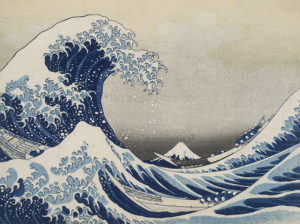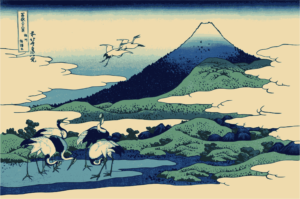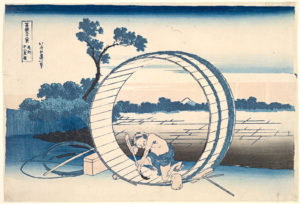 So to the current exhibition at the British Museum – Hokusai beyond the Great Wave (£12 entry, concessions £10).
So to the current exhibition at the British Museum – Hokusai beyond the Great Wave (£12 entry, concessions £10).
Katsushika Hosukai, also known as Iitsu and Gakyo Rojin Manji, was a painter from Edo (modern-day Tokyo) painting in late eighteenth and early nineteenth century Japan, just at the point when Japan opened up to the rest of the world. His most famous work is probably The Great Wave off Kanagawa (see above left) one of the Thirty Six Views of Mount Fuji which he produced in the 1830s.
The BM exhibition sets this work into the context of Hokusai’s life and his  work until his death, aged 90, when he was still working. A denizen of Edo, a city as large as London was at the time, Hokusai was a disciple of ukiyo-e ‘the art of the floating world’, which depicted and celebrated urban living, a style which reached great heights with Utamaro in the eighteenth century.
work until his death, aged 90, when he was still working. A denizen of Edo, a city as large as London was at the time, Hokusai was a disciple of ukiyo-e ‘the art of the floating world’, which depicted and celebrated urban living, a style which reached great heights with Utamaro in the eighteenth century.
Many of Hokusai’s works show people going about their daily lives, making a barrel, digging a hole in the road, taking the air and a look at nearby Mount Fuji from a viewing platform (there is a lovely little touch on the left of this picture, as the child drags at his mother’s kimono – ‘I’m bored, can we go yet?’). Trained in the classical Japanese manner, its tradition of portraying depth through ‘rising’ perspective and the importance of line, the exhibition contains examples of Hokusai’s earlier works – his dragons and fine ladies, both painted and printed using woodblock. But he was influenced by new ideas about art coming into Japan from Europe, particularly about naturalistic perspective and depth and by European colour and pigments, most particularly in his case, Prussian Blue.
 There is something Monet-esque about his painting and repainting the same view of Mount Fuji, at different times of day and different seasons and the Impressionists later acknowledged his influence. Hokusai also depicts different views of the mountain and uses its shape as a background in many works. I particularly like the blue picture of a man making a huge barrel, a giant circle that dominates this picture in the Views series, with Fuji just a small triangle within the circle.
There is something Monet-esque about his painting and repainting the same view of Mount Fuji, at different times of day and different seasons and the Impressionists later acknowledged his influence. Hokusai also depicts different views of the mountain and uses its shape as a background in many works. I particularly like the blue picture of a man making a huge barrel, a giant circle that dominates this picture in the Views series, with Fuji just a small triangle within the circle.
Hokusai augmented the traditional subject matter of the ukiyo-e with his  views of Fuji and other depictions of the natural world, his series on bridges and waterfalls. I particularly enjoyed the latter pictures. On one hand they are almost abstract in the way he depicts the water falling and its spray, in others full of perfect natural detail of the trees and plants and rocks, like tiny miniatures.
views of Fuji and other depictions of the natural world, his series on bridges and waterfalls. I particularly enjoyed the latter pictures. On one hand they are almost abstract in the way he depicts the water falling and its spray, in others full of perfect natural detail of the trees and plants and rocks, like tiny miniatures.
He was a popular artist during his lifetime, but his life was not without tragedy, both his wives dying young. Of his five children it was his daughter Oi who followed her father and became an artist and there are some examples of her, rare, work in the exhibition.
The exhibition also has many examples of Hokusai’s books, his manuals on painting and drawing and his illustrated Japanese myths and legends. And his sketch books, entitled manga – random sketches. There is no direct link to the modern Japanese narrative art of that name found in comic strips, although it was impossible to look at some of the drawings of evil demons without thinking of today’s depictions of the monster foes of modern Manga’s super-heroes.
Upon his death-bed Hokusai may have regretted much, but he is said to have regretted most of all that he couldn’t continue painting – “If only Heaven will give me just another ten years … Just another five more years, then I could become a real painter.”
This exhibition shows that he was.
It is located in the upper storey of the central Reading Room building in the Great Court. It is very popular, when we visited, access was by timed ticket only, so booking in advance is clearly necessary, at least at present. It runs from 25th May to 13th August ( closed 3 – 6 July ) and is well worth a visit.
If you enjoyed reading this article you might also enjoy Stars at Flowers Revolution Paul Nash Eric Ravilious


 RSS – Posts
RSS – Posts